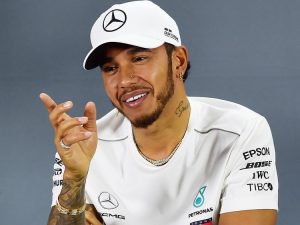

THE Formula 1 season will start in Australia this weekend amid a climate of uncertainty, anxiety and distrust.

Lewis Hamilton will start the season as the hot favourite to win the drivers’ championship.
There is anxiety over the global coronavirus outbreak, which has led to the postponement of the fourth race of the season, in China, and forced the second – in Bahrain – to be held behind closed doors.
There is uncertainty over just how significantly the virus could affect the season.
And there is distrust rooted in a major row between seven of the teams and the governing body over legality questions surrounding last year’s Ferrari engine.
This is all happening with F1 on the brink of two significant landmarks.
The first is individual: Lewis Hamilton is shooting for a seventh drivers’ world championship title, which would draw him level with Michael Schumacher.
The second is collective: As the sport celebrates 70 years of the world championship, this season will see the fastest cars in its history, before a new-look F1 in 2021 is expected to add seconds to lap times.
While the competition is being fought out on track at record speeds, the action behind the scenes will be just as frenetic.
There is the potential for a major shake-up in the driver market, as most of the big names – including Hamilton – have their contracts coming up for renewal. And there are some significant aspects of the plans for 2021 still to be finalised.
The coronavirus threat
Sunday’s Australian Grand Prix in Melbourne is going ahead, or so it appears at the time of writing. In F1, it’s normally a time of celebration and excitement as teams come out of their winter hiding and find out exactly where they stand heading into the long season.
This year, that anticipation is still there, but it is tempered by concern, as many in the sport ponder the implications of Covid-19.
Should F1 really be allowing 4,000 or so officials, team members and media to fly halfway around the world to hold a race in front of nearly 100,000 spectators at this time of global concern?
Governing body the FIA might have set up a “crisis cell” that meets every two days to analyse the coronavirus situation and their most appropriate response to it. But not everyone will agree that their current approach – which basically amounts to, ‘let’s keep an eye on things, but plough on pretty much as usual and hope for the best’ – is appropriate.
How many more races will be affected as the world battles to get the coronavirus under control?
Even Bahrain, in holding its grand prix behind closed doors, is giving out mixed messages, by waiving its own restrictions on travellers from outbreak-hit parts of the world – including Italy – to let in F1 personnel who are from or have travelled through those countries.
It is a situation that develops by the day, and in response to individual governments’ handling of the virus.
The Ferrari engine row
This opening race of the season looks like being a bad-tempered one.
Seven teams have come together to demand answers from the FIA as to why it failed to take action against Ferrari despite admitting suspicions that their engine was not always run legally in 2019.
Those teams also want to know why the settlement reached was confidential, with the FIA having concluded pursuing the matter was pointless because it would have been impossible to prove wrongdoing.
So far, there has been a back-and-forth exchange of media releases, but the seven teams are iron-determined to get answers.

Hamilton and the quest for seven
Hamilton starts the season as the hot favourite to win the drivers’ championship, based on the historic form of his partnership with Mercedes, now established as the most successful team in the history of the sport.
Their new car, the W11, has run impressively in testing, and features eye-opening technical innovations. All of Hamilton’s rivals are aware of the imposing nature of their task in trying to unseat him.
But while the outside world will focus on whether Hamilton can match Schumacher, the man himself says he has little time for records and statistics.
“It’s not something I think about,” Hamilton said at the final pre-season test. “I always say that numbers are not really a massive thing for me. I plan to be here a little bit longer so hopefully I’ll get there. We shall see.” Nor is he concerned about the fact that he has a target on his back for the ambitious young stars of Red Bull and Ferrari – Max Verstappen and Charles Leclerc – to aim at.
The pretenders
Verstappen set out his stall for 2020 some weeks ago, when he declared of Hamilton: “He is definitely one of the best out there but he is not God. Maybe God is with him, but he is not God.”
The provocative remarks did not go unnoticed by Hamilton, who responded: “I find it funny seeing that. I have just always known to do my talking on the track. I tend to see that as a sign of weakness.”
Verstappen heads into the season as the man many will see as the most likely to unseat Hamilton, if anyone can. The prospect of a battle between the two is mouth-watering.
When he builds up a head of steam, Verstappen is like a force of nature, and his determination, confidence, speed and hard-headedness would seem to stand him in good stead.
But his ability to challenge depends on whether his team, and engine partner Honda, have upped their game to a point where they can threaten Mercedes every weekend, rather than every now and again.
The driver market
Vettel’s future will be at the heart of what is known in F1 as the ‘silly season’ this summer, with only Verstappen and Leclerc sure of what they will be doing in 2021 after signing long-term deals with their teams over the winter.
All the other top drivers – Hamilton, Bottas, Vettel and Renault’s Daniel Ricciardo – are out of contract, along with a number of other drivers up and down the pit lane.
Hamilton is expected to stay where he is, assuming Mercedes stay in F1 – and team boss Toto Wolff has described reports that the board are considering their future as “complete nonsense”.
If Hamilton stays, do Mercedes stick with Bottas as his team-mate, or look elsewhere?
The behind-the-scenes stuff
The 2021 technical regulations were finally published last October after many months of wrangling, but several issues still need to be resolved before the start of F1’s new era next year.
Firstly, the new revenue split and governance systems have yet to be finalised, even if it seems a resolution is close.
Any doubts over the presence of Red Bull and Ferrari in 2021 seem to have been alleviated by the length of the contracts they have signed with Verstappen and Leclerc.
But there are questions over the future of Renault, whose board are undertaking a company-wide review of activities; Honda, who last autumn committed to Red Bull only until 2021; and the US-based Haas team. Even Mercedes’ presence cannot be taken for granted, in the context of the cuts being made by the Daimler group.
Beyond that, perhaps the single most important aspect of finalising 2021 is the tyres. F1’s new rules fundamentally change how F1 cars work, and have been formulated with the intention of allowing them to race closer together.
The tyres need their own redesign to facilitate this. In particular, they need to be much less sensitive to heat, a characteristic which forces drivers to drive seconds off the pace in races to make the tyres last required stint lengths, and which prevents close racing over extended periods. It’s fair to say there is scepticism among drivers and teams as to Pirelli’s ability to deliver. – bbc.com